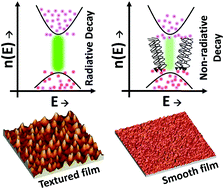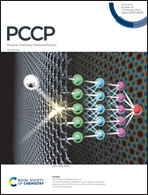Unraveling the antisolvent dripping delay effect on the Stranski–Krastanov growth of CH3NH3PbBr3 thin films: a facile route for preparing a textured morphology with improved optoelectronic properties†
Abstract
Inorganic–organic hybrid perovskite materials have been a topic of interest for the last few years due to their superior optoelectronic properties. However, the optical properties of perovskite materials are strongly dependent on the film morphology. A textured film morphology is expected to have higher light absorption as well as light out-coupling efficiency compared to a smooth film. There have been numerous methods for controlling and optimizing the film morphology to achieve high efficiency in solar cells and light emitting diodes. Here we have demonstrated that controlled anti-solvent treatment at low temperature can lead to Stranski–Krastanov growth in CH3NH3PbBr3 thin films with superior optical and electronic properties for light emitting diode applications. We have studied their photoluminescence properties at the micro- to nano-scale via fluorescence microscopy, hyper-spectral imaging and scanning near-field optical microscopy. We have demonstrated that the nanostructured micro-islands are highly emissive because of large quasi-Fermi level splitting (QFLS) due to the localization of free charges in the smaller crystals. We have shown that the photoluminescence as well as electroluminescence can be improved by at least seven-fold due to the presence of micro-islands on a smooth background film enhancing light out-coupling. Photo-induced photoluminescence enhancement is also observed in smooth films while micro-islands show photo-degradation.

- This article is part of the themed collection: 2021 EES Lectureship winner: Sam Stranks


 Please wait while we load your content...
Please wait while we load your content...